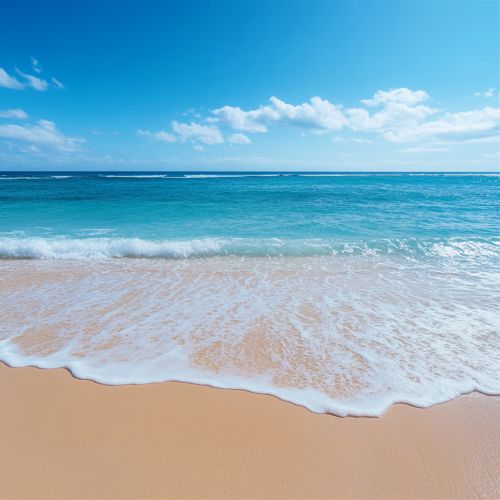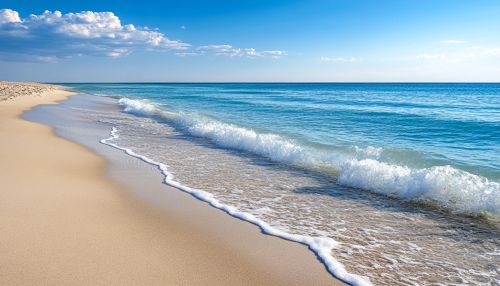Gulf of Mexico
Introduction
The Gulf of Mexico is a vast ocean basin located in the southeastern region of North America, bordered by the United States to the north, Mexico to the west and south, and Cuba to the southeast. This semi-enclosed sea is an integral part of the Atlantic Ocean and plays a crucial role in the region's climate, economy, and biodiversity. Its unique geological history, diverse ecosystems, and significant human impact make it a subject of extensive scientific research and environmental concern.
Geological Formation and Structure
The Gulf of Mexico was formed approximately 300 million years ago during the late Paleozoic era. Its formation is attributed to the rifting of the supercontinent Pangaea, which led to the opening of the Atlantic Ocean. The Gulf's current structure is a result of complex geological processes, including tectonic plate movements, sediment deposition, and sea level changes.
The Gulf is characterized by its broad continental shelf, particularly along the northern and eastern coasts, which gradually slopes into the deeper central basin. The deepest part of the Gulf is the Sigsbee Deep, also known as the Sigsbee Abyssal Plain, which reaches depths of over 4,300 meters. The Gulf's geology is further complicated by the presence of salt domes, which are large underground salt deposits that have risen through the sediment layers, creating unique topographical features and influencing oil and gas formations.
Climate and Oceanography
The climate of the Gulf of Mexico is predominantly subtropical, with warm temperatures and high humidity levels. The region is heavily influenced by the Gulf Stream, a powerful ocean current that originates in the Gulf and flows into the Atlantic Ocean. This current plays a significant role in regulating the climate of the eastern United States and Western Europe by transporting warm water northward.
The Gulf is also known for its susceptibility to tropical cyclones, particularly hurricanes, which form over the warm waters during the Atlantic hurricane season from June to November. These storms can have devastating impacts on coastal communities and ecosystems.
Oceanographically, the Gulf is characterized by its complex circulation patterns, driven by the Loop Current, a warm ocean current that enters the Gulf through the Yucatán Channel, loops around the Gulf, and exits through the Florida Straits. This current is a critical component of the larger Atlantic Meridional Overturning Circulation, which influences global climate patterns.
Biodiversity and Ecosystems
The Gulf of Mexico is home to a rich diversity of marine life, supported by its varied habitats, including coral reefs, seagrass beds, mangroves, and salt marshes. These ecosystems provide crucial services such as carbon sequestration, water filtration, and habitat for numerous species.
Coral reefs in the Gulf, such as the Flower Garden Banks National Marine Sanctuary, are biodiversity hotspots, hosting a wide array of fish, invertebrates, and marine mammals. However, these reefs face threats from climate change, ocean acidification, and human activities.
The Gulf's estuaries and wetlands are vital breeding and nursery grounds for many species, including commercially important fish and shellfish like shrimp, red snapper, and oysters. These areas also support a variety of bird species, including migratory birds that rely on the Gulf's habitats during their long journeys.
Human Impact and Environmental Concerns
The Gulf of Mexico is a region of significant economic importance, primarily due to its oil and gas reserves, fisheries, and tourism. The Gulf Coast is a major hub for the petroleum industry, with numerous offshore drilling platforms and refineries. However, this industry has also led to environmental challenges, including oil spills, habitat destruction, and pollution.
One of the most notable environmental disasters in the Gulf was the Deepwater Horizon oil spill in 2010, which released millions of barrels of oil into the Gulf, causing extensive damage to marine and coastal ecosystems. The spill highlighted the need for improved safety measures and environmental regulations in the oil and gas industry.
In addition to oil spills, the Gulf faces other environmental issues such as hypoxia, commonly known as the "dead zone," where low oxygen levels in the water lead to massive fish kills and disrupt marine life. This phenomenon is primarily caused by nutrient runoff from agricultural activities in the Mississippi River Basin.
Conservation and Management Efforts
Efforts to conserve and manage the Gulf of Mexico's natural resources are ongoing, involving collaboration between government agencies, non-governmental organizations, and the scientific community. Key initiatives focus on habitat restoration, pollution reduction, and sustainable fisheries management.
The Gulf of Mexico Alliance, a regional partnership, works to address environmental challenges through coordinated efforts across state and national boundaries. This alliance emphasizes the importance of science-based decision-making and stakeholder engagement in conservation efforts.
Marine protected areas (MPAs) have been established to safeguard critical habitats and biodiversity in the Gulf. These areas restrict certain human activities to preserve the ecological integrity of the region. Additionally, restoration projects aim to rehabilitate damaged ecosystems, such as wetlands and coral reefs, to enhance their resilience to environmental stressors.
Cultural and Historical Significance
The Gulf of Mexico has a rich cultural and historical heritage, shaped by the diverse communities that have inhabited its shores for centuries. Indigenous peoples, such as the Calusa and Karankawa, relied on the Gulf's resources for sustenance and trade long before European exploration.
The Gulf played a pivotal role in the age of exploration and colonization, serving as a gateway for Spanish, French, and British expeditions. Its strategic location made it a focal point for trade and conflict, influencing the development of the surrounding regions.
Today, the Gulf continues to be a cultural melting pot, with vibrant communities that celebrate their unique traditions and connections to the sea. The region's cuisine, music, and festivals reflect the diverse influences that have shaped its identity.
See Also


